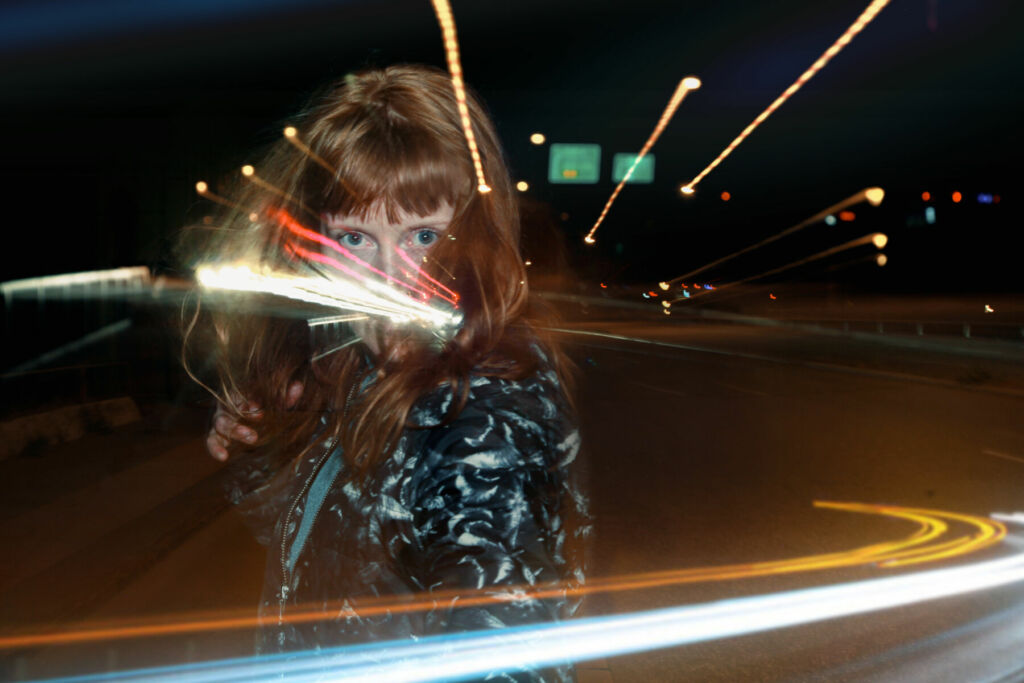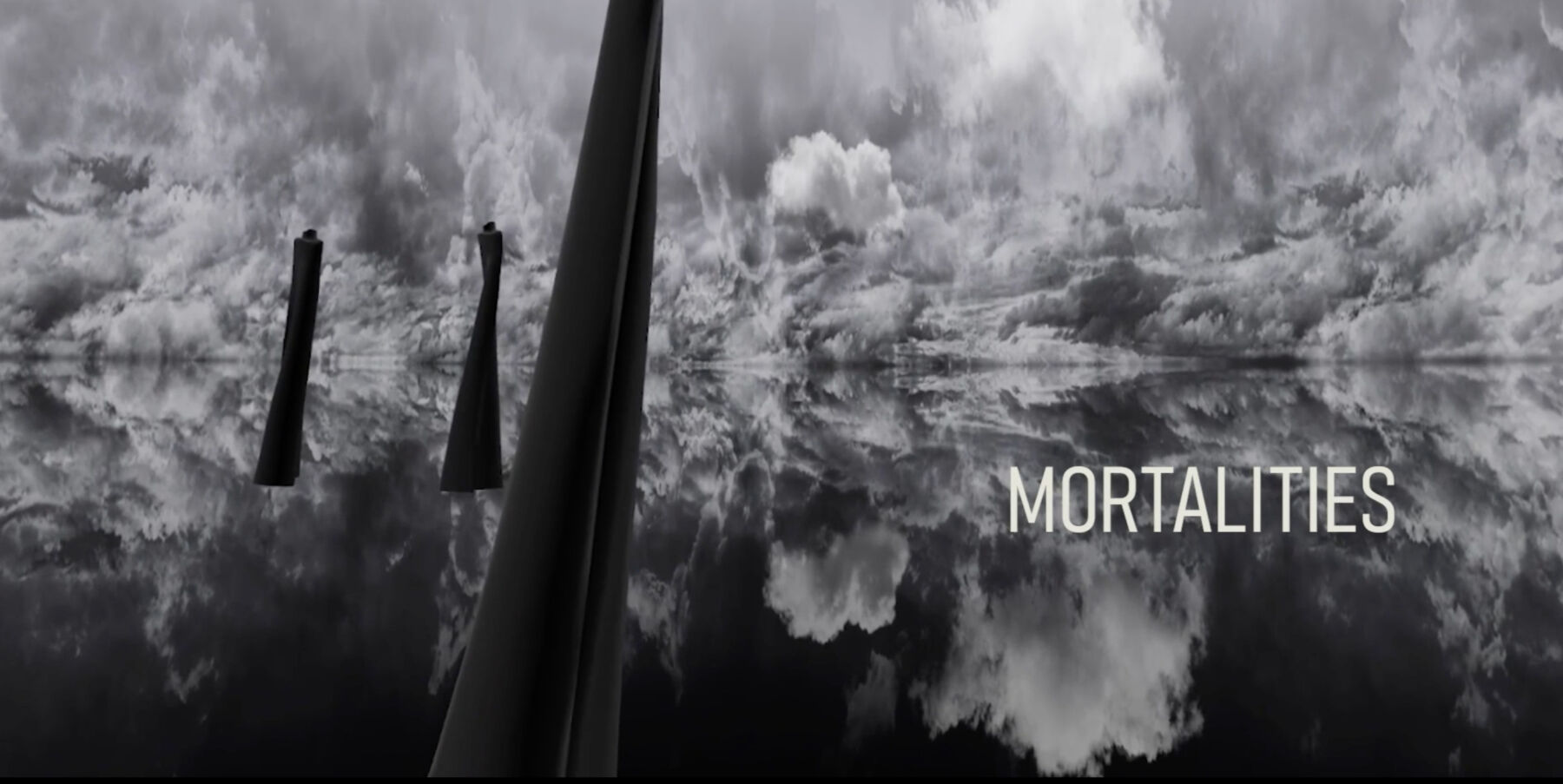Interview by Olya Karlovich

One can describe SØS Gunver Ryberg‘s music as tense, pulsating, and industrial. In the electronic scene, the artist became famous for breathtaking live performances and records in which a flurry of techno beats is intertwined with powerful noise and ominously beautiful drones. Her latest album is sparkling with its dreamy sequences and sonic expressionism and also has all the previously mentioned qualities inherent in Ryberg’s sound. Still, the tone has changed — the thunderclouds have parted, revealing sophisticated futuristic soundscapes on the cusp of IDM, ambient, techno, and dub.
The artist always manages to skillfully erase genre boundaries and combine what may seem incompatible at first glance. And this is, without a doubt, the result of her rich and diverse creative experience. Years of working with performative art, studying at a conservatory, and creating music for video games and sound installations, are just a few milestones in Ryberg’s prolific career. She was never afraid of challenges and changes, freely stepping into another exploratory ‘adventure’. Thus, during her Tresor debut, she decided to try out Kyma, a very advanced hardware and software for creative sound design and live performance.
Ryberg has always had a special relationship with technology. They are integral to the artist’s creative process, allowing her to push the boundaries of sonic possibilities and explore new territories. And what is also really interesting, she finds connecting points between the sound of machines and the sonic palette of nature. For example, on the AFTRYK EP, we can hear some of the material recorded during the artist’s trip to the Norwegian Svalbard island. And this music is the perfect synergy of the synthetic and the organic.
Interconnectedness also plays an important role in Ryberg’s practice in general, whether exploring the boundaries between technology and nature or different mediums. Aiming to create a multi-sensory immersive experience, she actively collaborates with digital artists and combines sound and visual aspects. Ryberg recently teamed up with 3D artist Patrick DeFasten to build a vibrant abstract cyber world for SPINE. Dynamically changing and rotating images in the video for the Out of the Shadows track continue the musical narrative of the album, which speculates on the theme of a sustainable future.
Constantly striving to develop as a composer and artist, Ryberg likes to be in an endless creative flow. She still has quite a busy schedule and is involved simultaneously in several projects. This year she presented an LP, wrote music for the VR opera MORTALITIES, and launched a label Arterial Recording. According to the artist, Arterial provides a platform to expand her artistic goals and reflect the world she wants to see in the future. But what will this world look like? We have yet to explore. One thing is for sure, music plays the guiding role there, opening up spaces for imagination and reflection and putting us in a more curious connection with the outside world.


You earned a degree from The Danish National Academy Of Music. How has it influenced the kind of artist/musician you are today? Do you think that a professional education benefits an artist or, on the contrary, somehow blocks creative freedom because you can get stuck following certain rules and guidelines?
It depends on the individual artist and how the education is structured; there is flexibility, who is teaching, where the artist is in their life and artistic development, what they need etc. For instance, I don’t like the conservatory (in DK) giving grades on exams. In my opinion, they should only do feedback. Often artists get too focused on the grade and miss the actual learning/knowledge in the feedback.
I never thought I would take an education from the music conservatory. I imagined more the art academy. I heard about my education which at that time was relatively new and thought it sounded more interesting as I would get more tech learning than the art academy. I took a BA, and I had the thought to apply for something else abroad. I didn’t know whether it should be more music or art. Before deciding, I got a job at the video game company Playdead for almost four years and never returned to the school system.
At the conservatory, I was introduced to different ways of thinking about sound art, some history, electroacusmatic music and different artists’ work. I learned how to work more conceptually with my pieces. What I really took with me from there are multi-channel compositions and spatializing sound to create even more immersive experiences than working cross-media.
I came from the art / experimental performance scene into the conservatory. I wasn’t really listening to electronic music so much. I was introduced to working with synths and drum machines, which I really got into as I wanted to expand my expression.
Your latest SPINE album is inspired by science fiction, bringing the idea of a sustainable future ‘buoyed by interconnectedness, empowerment and understanding’. And this also pretty much reflects the philosophy of your newborn Arterial label. Can you please elaborate on this ‘positive futurism’ concept? And how did you come up with it?
My inspiration is envisioning a better future and inspiring societal change and progress. We have the power to shape the future. Creating a sustainable future is a goal and a way of being where we are in tune with ourselves and nature, recognizing our interconnectedness with everything. We are in existential urgency of finding new ways and solutions to our challenges.
The Inspiration came from my everyday life. Not science fiction or positive futurism. I wanted to change some patterns I was in with my work. I was working way too much and have been doing this for more than 10 years. When people went on Holidays, I was always working cause I love what I do. I’m HSP (highly sensitive personality), but I was not fully living my life
according to being HSP. In the last few years, I reached a point where I realized it was unsustainable for me to keep working at that tempo and not take better care of my sensitivity. I’m not completely there as many projects are still on my calendar, but now I know what I’m saying yes to in the future. For me, one of the ways to achieve interconnectedness is through listening/ listening with all my senses. I hope SPINE will open up the listener and give space for imagination and visions. Music can put us in a more curious connection with our surroundings and have the potential to raise awareness, create empathy and promote action to address challenges.
Your music can sound pretty Industrial, and it is very advanced in terms of the technology you use. However, nature is also an inspirational source for your work. What fascinates you about such an intersection of technology and the living world? And how do you find balance as you explore these two worlds in your practice?
We are surrounded by technology. We use it every day. Our society is becoming more and more digitized. I use technology for my music, so it’s linked to something very creative. It enables me to explore new sonic landscapes, experiment with intricate sound design, and push the boundaries of what is sonically possible.
I explore the dynamics. To me, industrial can sound organic and nature sounds can be raw and harsh. I remember when I made field recordings in Svalbard 15 years ago. The sounds I came home with were so noisy, raw, barren, and intense.
I’m very interested in technology development, and as Donna Haraway argues, technology isn’t neutral. It shapes how we see things and distribute power. We and technology are interconnected. It changes who we are and how we relate and influences how we experience and understand the world. These connections can help us or hold us back.
Understanding which connections are made and ignored is important because they affect society, culture, and politics. By recognizing this, we can carefully consider the impact of technology and work towards more inclusivity and justice. So, I’m now considering how collaborating with others can potentially influence technology.
You recently released a beautiful collaborative Out of the Shadows work with a 3D artist Patrick Defasten. And there is another Mirrored Madness video. Also, you are currently working with a 3D artist Ida Lissner. How will you describe the relationship between sound/music and visuals in your projects? What experience do you want to convey by bringing these mediums together?
The relationship between sound/music and visuals is integral to my creative process. I view sound and visuals as two interconnected realms that have the power to enhance and elevate each other, creating a multi-sensory immersive experience for the audience.
When collaborating with amazing visual artists such as Patrick Defasten and Ida Lissner, the visuals provide an abstract visual language that complements and amplifies the emotions embedded within the music. It enhances the mood, highlights certain sonic elements, or even creates a counterpoint that adds depth and complexity to the overall experience. I received another perspective of what I created. Together it becomes a unified artistic vision.
As far as I know, you are already starting to work on your next release. Can you share some details of this project with our readers?
I always create without talking about it before it’s done.
It’s a deeper exploration of thoughts and concepts from my album SPINE. It has an element that I don’t usually work with in my music. The rest is for me to explore
Do you usually start with concept development when working on a new record? Or does the music come first, and then the concept evolves around it?
For my releases, I start with the music, and after some time, I reflect on what I’m doing. I don’t want to be actively conscious. It’s more about letting go and something else to guide me. Though with the next release, I do have thoughts and concepts, but it’s also because a lot of the music I didn’t finish for SPINE so Im already in the middle of a process with the music.
Along with producing and releasing electronic music, you compose in immersive formats such as multi-channel works, installations, performances, films, games, VR/AR, etc. How does your creative approach change depending on the medium you work with?
Every medium has different ways I need to approach composition depending on the format. I use different compositional thinking, so there are many factors one has to be aware of; I use different techniques and technologies. It depends on so many factors, actually. I enjoy these changes. There is a research process in every project into philosophy, literature, art, science, world history, etc.
There are some feelings that I might not otherwise have explored, and I think that only helps to strengthen myself as a person and a composer. The most important thing is that I constantly keep developing as an artist. For me, it is very natural to express my music through several media. It is only as a further development of my expression alongside my concerts and releases. People ask me for collaborations because they have heard my music.
What is more important: to take or not to take yourself too seriously in order to be creative?
Playfulness is very important as I need to create space for exploration, experimentation, and embracing the unexpected. It’s one of my favourite parts of creating to be in this unknown space. Openness, ideas, and curiosity is what drives me.
I do also need seriousness to prioritize and structure my creative explorations, and invest time and effort into it. Towards the end of a project, I most often end up being too serious. As I have invested so much time and energy into something, I don’t want to compromise in the end.
One for the road… What are you unafraid of?
Right now hanging out with my cat and learning from her.






